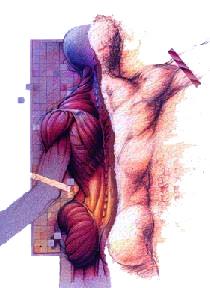Fibromyalgia Rehabilitation

The Physical Medicine and Rehabilitation Physician ... Adding Quality to Life
| Advanced Medical Rehabilitation Group | |
| Gary DiBlasio, M.D., P.A. | |
| 701 Northlake Boulevard North Palm Beach, FL 33408 ● Suite 208 | |
|
1807 South Kanner Hwy, Stuart, FL 34994 |
|
|
Voice: (561) 863-2828 ● Fax: (561) 863-2914 |
|
|
Dedicated to the state-of-the-art non-invasive medical treatment of spine and pain disorders. |
|
|
|
|
What is fibromyalgia?Fibromyalgia is a chronic disorder that causes widespread pain and tenderness in the muscles and soft tissue (including tender points) as well as sleep problems, fatigue, and a variety of other symptoms. These problems can be severe enough to disrupt a person's work and daily activities. Fortunately, the condition does not permanently damage the muscles, joints, or internal organs.Fibromyalgia is a syndrome of chronic pain, not a disease or a psychological disorder. |
 |
|
Tender points are specific sites on the body that cause pain when pressed. The pain may spread when a tender point is pressed and cause pain in a larger area (for example, down the leg, arm, or back). There are 9 pairs of tender points. Each pair has one point on each side of the body, for a total of 18 points. These pairs are located:
To clearly diagnose fibromyalgia, a person must have pain at 11 or more of the 18 tender points. In practice, however, many people with fibromyalgia have fewer than 11 tender points. |
|
The variety and severity of symptoms caused by fibromyalgia vary from person to person. Widespread, chronic pain is the most common symptom. It usually develops gradually. Other symptoms that commonly occur in addition to pain include:
Less commonly people with fibromyalgia may have:
No one has a clear understanding of what causes fibromyalgia. There are theories as to what may cause it, but there is not enough evidence to support any single theory. Since fibromyalgia is a syndrome of many symptoms, it has been difficult to find a specific cause for the combined symptoms. It has been recognized as a medical disorder only since the 1980s.Some theories suggest that fibromyalgia may be:
Currently, there is no cure for fibromyalgia. Treatment is focused on managing pain, fatigue, depression, and other symptoms common in fibromyalgia in an attempt to break the cycle of increased sensitivity to pain and decreased physical activity. Treatment may include:
Other Treatment A variety of other treatments have been used to treat conditions that cause chronic pain. Most of these complementary or alternative therapies are not proven treatments for fibromyalgia, but they may be helpful when symptoms flare up and may improve quality of life. Safe complementary therapies such as acupuncture or massage, for instance, may help relieve stress, ease muscle tension, and help you feel better and healthier. Other Treatment ChoicesOther treatments that may be used to treat fibromyalgia include:
Those treatments should be coordinated through a Physiatrist who has extensive training and experience with this disorder |
|